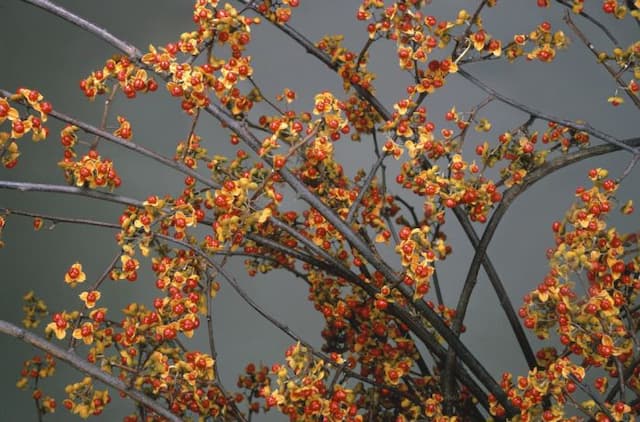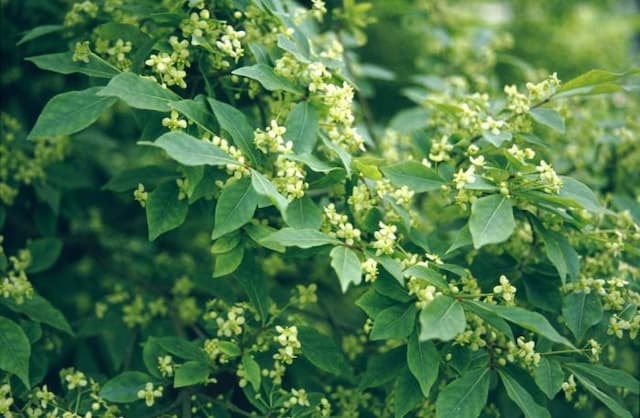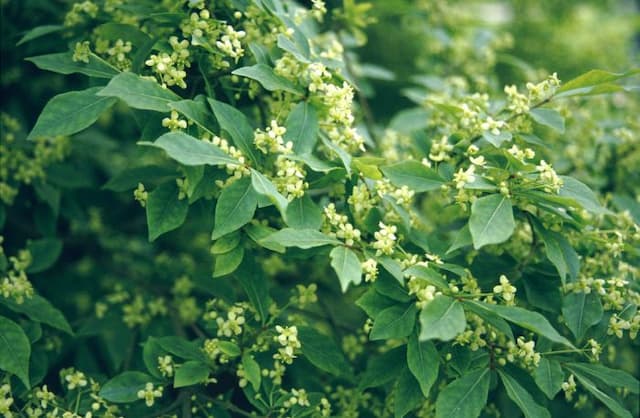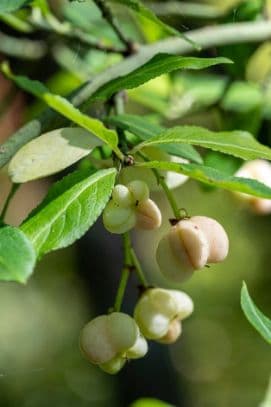Golden Euonymus Euonymus japonicus 'Aureomarginatus' (v)
ABOUT
The Euonymus japonicus 'Aureomarginatus,' commonly known as the Golden Euonymus, is a striking evergreen shrub known for its eye-catching foliage. The plant features glossy, leathery leaves that are oval-shaped with pointed tips. What sets the Golden Euonymus apart is the beautiful variegation of its leaves. The center of each leaf is a rich green color while the margins are broadly edged with a vibrant golden-yellow, creating a bold contrast that can brighten any landscape. The leaves are arranged oppositely on the stems, giving the shrub a dense, bushy appearance. The variegated leaves not only add a splash of color but also a textural quality to garden spaces, making the Golden Euonymus a popular choice for hedges, borders, or as a stand-alone specimen. Additionally, this plant can produce small, inconspicuous greenish-white flowers in the late spring or early summer, though they are not particularly showy and are often overlooked in favor of the plant's stunning foliage. Throughout the year, the Golden Euonymus maintains its vibrant coloration, providing year-round interest in the garden. Due to its evergreen nature, it keeps its leaves throughout the winter months, offering a constant display of golden-edged greenery even when other plants have lost their leaves. The combination of its colorful foliage and resilient nature makes the Golden Euonymus a favorable choice for gardeners looking to add all-season interest to their outdoor spaces.
About this plant
 Names
NamesSynonyms
Golden Euonymus, Japanese Spindle, Evergreen Euonymus, Variegated Japanese Euonymus.
Common names
Euonymus japonicus 'Aureomarginatus' (v)
 Toxicity
ToxicityTo humans
The Japanese Spindle is considered to be toxic to humans if ingested. The parts of the plant, including the leaves and berries, contain compounds that can cause symptoms such as nausea, vomiting, diarrhea, weakness, chills, coma, and convulsions. Ingestion of parts of this plant can lead to serious health implications and medical attention should be sought immediately if ingestion is suspected.
To pets
The Japanese Spindle is toxic to pets, including dogs and cats. The plant contains alkaloids and other compounds that can cause symptoms similar to those in humans, such as vomiting, diarrhea, weakness, and in severe cases, seizures or convulsions. If a pet ingests any part of this plant, it is important to seek veterinary care immediately to prevent potentially serious health consequences.
 Characteristics
CharacteristicsLife cycle
Perennials
Foliage type
Evergreen
Color of leaves
Variegated
Height
6 feet (1.83 meters)
Spread
4 feet (1.22 meters)
Plant type
Shrub
Hardiness zones
6-9
Native area
Japan
Benefits
 General Benefits
General Benefits- Ornamental Value: Euonymus japonicus 'Aureomarginatus', commonly known as golden variegated euonymus, has attractive evergreen foliage with golden-yellow margins, adding color and visual interest to gardens year-round.
- Low Maintenance: This shrub is known for being easy to care for, requiring minimal pruning and watering once established, making it suitable for low-maintenance landscapes.
- Drought Tolerance: Once established, golden variegated euonymus can tolerate dry conditions, reducing the need for frequent watering and aiding in water conservation.
- Versatility: The plant can be used in various landscaping settings, including as a hedge, screen, or specimen plant, providing flexibility in garden design.
- Pest Resistance: Golden variegated euonymus is relatively resistant to pests, decreasing the need for chemical treatments and making it a safer choice for gardens frequented by pets and children.
 Medical Properties
Medical PropertiesThis plant is not used for medical purposes.
 Air-purifying Qualities
Air-purifying QualitiesThis plant is not specifically known for air purifying qualities.
 Other Uses
Other Uses- Privacy Screening: Euonymus japonicus 'Aureomarginatus' can be grown as a hedge or screen to provide privacy in residential gardens.
- Topiary Art: Due to its dense foliage and ability to withstand pruning, it can be shaped into various topiary forms for decorative purposes.
- Erosion Control: It can be used on slopes or banks to prevent soil erosion because of its extensive root system.
- Backdrop for Other Plants: Its variegated leaves provide a contrasting backdrop that can enhance the appearance of flowering plants in a mixed border.
- Urban Landscaping: Resistant to pollution, it's well-suited for urban settings and can be planted along streets or in public parks.
- Aquarium Use: Small cuttings can be used in aquariums to provide a natural and attractive look, though they will not survive underwater long-term.
- Festive Decorations: Branches can be used in festive wreaths and garlands during the holiday season.
- Photography Prop: Its bright foliage makes it a photogenic plant that can be used by photographers as a prop in garden photography.
- Windbreaks: For areas with strong winds, Euonymus japonicus 'Aureomarginatus' can act as a windbreak when planted in rows.
- Craft Material: The wood of older stems could be used in small craft projects, such as making simple plant supports or frames.
Interesting Facts
 Feng Shui
Feng ShuiThe Golden Euonymus is not used in Feng Shui practice.
 Zodiac Sign Compitability
Zodiac Sign CompitabilityThe Golden Euonymus is not used in astrology practice.
 Plant Symbolism
Plant Symbolism- Endurance: The Euonymus japonicus 'Aureomarginatus', commonly known as the golden euonymus, is an evergreen shrub that maintains its foliage all year round, symbolizing persistence and the ability to endure varying conditions.
- Versatility: Due to its usage in various landscaping designs, ranging from hedges to standalone shrubs, the golden euonymus represents adaptability and flexibility.
- Fertility and Growth: With its ability to grow relatively fast and its lush green leaves edged with gold, the golden euonymus often symbolizes fertility, growth, and the abundance of life.
- Protection: This plant is often used in hedges, which can act as living barriers, thus it may be associated with safety, shelter, and protection.
- Prosperity: The vibrant golden-edged leaves can be seen to symbolize wealth, prosperity or success, making it an auspicious plant for many people.
 Water
WaterThe Golden Euonymus should be watered deeply until the water starts to run out of the drainage holes, which is typically about 1 to 1.5 gallons for a medium-sized pot. Watering frequency depends on the climate and the plant's environment, but a general rule of thumb is to water once every 7 to 10 days, allowing the soil to dry out partially between waterings. Over the winter months, reduce the amount to prevent waterlogging as plant growth slows down, which might mean watering every 10 to 14 days. Adjustments should be made based on the weather, with more frequent watering in hot, dry periods and less during cool, damp conditions.
 Light
LightGolden Euonymus thrives best in full to partial sunlight. Locating the plant in a spot where it can receive at least 4 to 6 hours of direct sunlight is ideal. However, it can also tolerate partial shade, which can be beneficial during the hottest part of the day or in regions with very intense sun. Ensure it does not receive too much shade, as this can result in less vibrant foliage.
 Temperature
TemperatureGolden Euonymus is hardy and adapts well to a range of temperatures, but it prefers conditions between 60 to 75 degrees Fahrenheit. While it can survive in temperatures as low as 0 to 10 degrees Fahrenheit, prolonged exposure to this cold can be harmful, and temperatures above 80 degrees Fahrenheit might stress the plant. Ideal growth occurs within the specified range, but this robust shrub can manage outside of it for short periods.
 Pruning
PruningPruning Golden Euonymus is important to maintain its shape and promote dense growth. The best time to prune is late winter or early spring before new growth starts. Generally, pruning can be done once or twice a year, depending on the desired shape and size of the plant. Always use clean, sharp tools to make clean cuts, removing any dead or damaged branches, and to encourage new shoots.
 Cleaning
CleaningAs needed
 Soil
SoilThe Golden Euonymus thrives best in a well-draining soil mix with peat moss, compost, and perlite or sand. It prefers a slightly alkaline to neutral pH, between 6.0 and 7.5. Amending the soil with organic matter helps improve soil structure and nutrient content.
 Repotting
RepottingGolden Euonymus does not need frequent repotting and can be repotted every 2 to 3 years. Choose a slightly larger pot each time to allow for growth, and ensure it has adequate drainage holes.
 Humidity & Misting
Humidity & MistingThe Golden Euonymus tolerates a wide range of humidity levels but prefers moderate humidity. Average indoor humidity is generally suitable, and there is no need for any special humidity adjustments.
 Suitable locations
Suitable locationsIndoor
Place in bright, indirect light and avoid overwatering.
Outdoor
Full sun to partial shade, shelter from strong winds.
Hardiness zone
6-9 USDA
 Life cycle
Life cycleThe life cycle of Euonymus japonicus 'Aureomarginatus', commonly known as the Gold Edge Euonymus, begins with seed germination, occurring when the environmental conditions are favorable, such as warm temperatures and moist soil. Following germination, the seedling grows and develops into a young plant with characteristic variegated leaves, which are green with golden-yellow edges. As the plant matures, it enters a vegetative state where it increases in size and produces dense, evergreen foliage, becoming a popular ornamental shrub. The Gold Edge Euonymus may produce small, inconspicuous flowers that are greenish-white in color, typically in late spring or early summer. If pollination occurs, these flowers will develop into pinkish-red fruits which can split open to reveal orange seeds when mature. Throughout its life, the plant may be pruned to shape or control size and can live for many years, forming a mature, woody structure with time.
 Propogation
PropogationPropogation time
Late summer to autumn
The Golden Euonymus, also known as Euonymus japonicus 'Aureomarginatus', is typically propagated through semi-hardwood cuttings. The best time to take these cuttings is during the summer when the new growth has partially matured but is not yet fully hardened, which is normally from late June to August. To propagate this plant, select a healthy stem and cut a 4 to 6 inch (10 to 15 cm) length of semi-hardwood. Strip away the lower leaves, and dip the cut end in rooting hormone to encourage root development. Then, insert the cutting into a well-draining rooting medium such as a mix of peat and perlite. The cutting should be kept moist and in indirect light until roots have established, after which it can be potted up or planted out.




![Spindle [Blondy]](/_next/image?url=https%3A%2F%2Fplants-admin.emdemapps.com%2Fimages%2Fplants%2F%2Fimages%2F604b642f54add.png&w=640&q=75)


